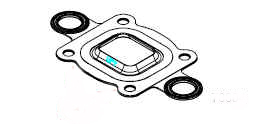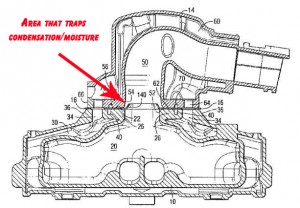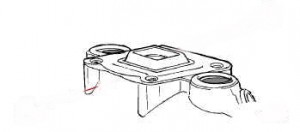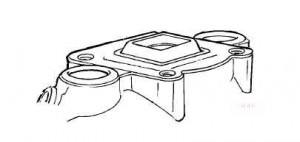I thought this was interesting enough to share /manifold riser gasket
 Trashman
Member Posts: 432 ✭✭✭
Trashman
Member Posts: 432 ✭✭✭
Marine Exhaust Turbulators

QUESTION: What is the purpose of the “Turbulator” used in Mercruiser Marine Exhaust Systems”.
This is a question Performance Product Technologies receives on a regular basis being the leading technical source for Marine Exhaust products and technical information. The history of the “Turbulator” dates back to 1932 if you look at the original patent filings for such devices. However the most similar design to the way it was patented and is currently being used by Mercruiser dates back to a patent filed by Jerry Gilbreath, who at the time was the owner of Gil Marine. Gil Marine was later purchased by Corsa products and later sold to CP Performance who now produces the Gil Exhaust systems through their Hardin marine division.
The basis for the “Turbulator” stems from the need to prevent condensation generated within the exhaust system from entering a Marine Engine through the exhaust manifold and riser. Through the basic process of combustion the exhaust temperature generated with the standard internal combustion marine engine reaches approximately 650F – 750F when idling. With the “Cold Manifold” type cooling systems (click on this link to read more about cold versus warm manifold cooling systems) the cooling jackets of the manifold and riser never reach much above 100F. The result of this 650F versus 100F temperature difference is much like what you will see with a cold glass of iced tea sitting outside on a hot summer day. The result: excessive moisture condensing within the inner passages of the exhaust. In some cases the amount of condensation can be enough to actually cause engine misfire if the exhaust is configured such that enough of this condensation makes its way back into the engine.
Without going into a full blown engineering analysis of the “Turbulator” we will provide a brief explanation of how it functions. The basic premise is based on the following design intentions;
- The angled section of the plate creates a small reservoir once clamped between the exhaust manifold and riser/elbow (see image directly below). This reservoir then acts as a trap to catch and contain any condensation that is collecting on the internal exhaust passages. This reservoir also collects and water that may be present in the exhaust gas originating from water reversion.
- The reduction in cross-sectional area as the exhaust flows through the “Turbulator” causes a low pressure area within the reservoir of the “Turbulator” itself at the very point where the condensation is collecting. As the exhaust passes through the “Turbulator” and the reduction in flow area the exhaust gas velocity increases which allows the exhaust gas to pull out any condensation collected in the reservoir, that hasn’t already been evaporated by the heat of the exhaust.

Therefore in summary the “Turbulator” is an effective design at helping to reduce the effects of condensation however the best overall approach in our opinion is the “Warm Manifold” type cooling system. The “Warm Manifold” cooling system design offers other advantages such as more consistent temperatures, better results at preventing moisture from reaching the engine, etc. The following links point to the various Mercruiser product locations where you will find the “Turbulator” being used;



Comments
Go Steelers!!!
Dream 'Inn III -- 2008 400 Express